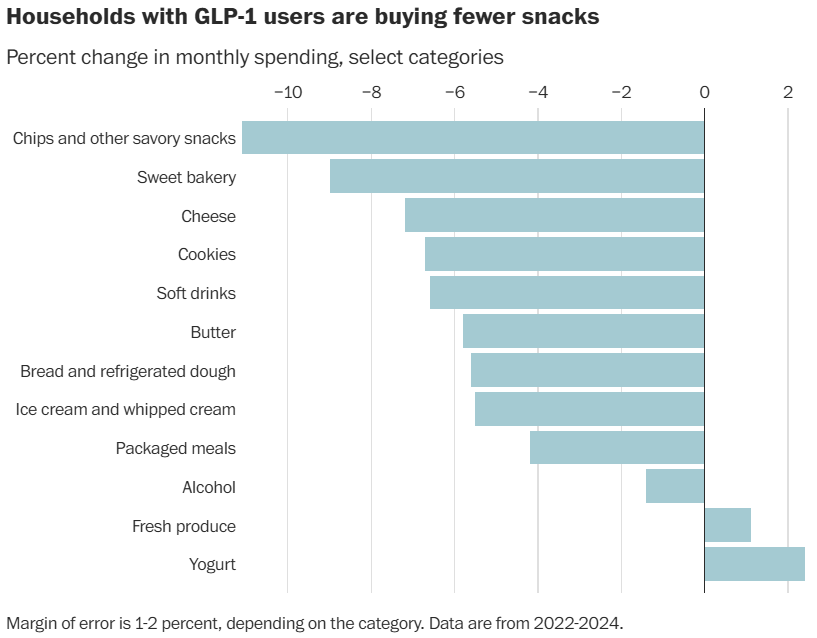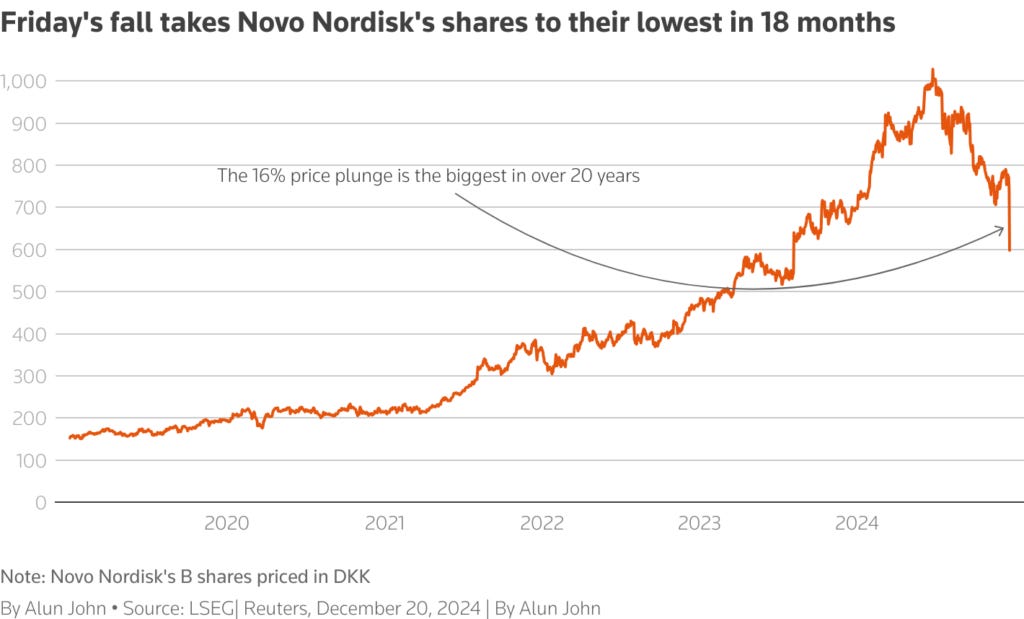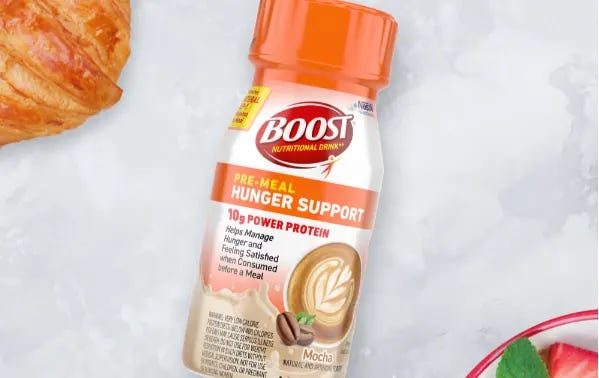The Gut Punch Weekly #1
GLP-1s will disrupt the economy in 2025, FDA declares the tirzepatide shortage over, Novo Nordisk stock plummets, and much more.
Introducing The Ozempic Era
Obesity has eaten the world. Over 40% of American adults now live with obesity 1 – a more than threefold increase from the 13% recorded in the early 1960s 2. Today, nearly three-quarters of Americans are considered overweight or obese. The numbers are staggering, almost incomprehensible in their scale: in just two generations, we’ve witnessed the most dramatic transformation of human bodies in recorded history.
But this isn’t just an American story anymore. What began as a crisis of affluence in Western nations has morphed into a global pandemic that defies old assumptions about wealth, culture, and diet. China and Saudi Arabia 3, riding waves of newfound prosperity, have seen obesity rates skyrocket as they’ve adopted the trappings of Western consumer culture. More shocking still, regions of the world that were battling undernourishment just decades ago – from Latin America to sub-Saharan Africa to Southeast Asia – now find themselves inundated with an excess of cheap, empty calories 4.
This unprecedented reshaping of human bodies isn’t a crisis of willpower – it’s a hijacking. Over the past 50 years, multinational food conglomerates have used Big Tobacco’s addiction playbook to dismantle traditional foods and replace them with “craveware” – highly addictive food products specifically designed to hack our brain’s reward circuitry and drive compulsive consumption 5.
The result? Over the past 50 years, we’ve witnessed a seismic shift in global diets, marked by an ever-increasing reliance on processed foods, meals eaten away from home, and the ubiquitous presence of edible oils and sugar-sweetened beverages 6. This transformation accelerated with globalization, as transnational food conglomerates exported their highly addictive, ultra-processed products to every corner of the globe.
For decades, the weight loss industry has thrown everything but the kitchen sink at this problem. Fad diets, meal replacement shakes, point-counting systems, appetite suppressants, major surgeries – each promising to be the silver bullet that would finally reverse the tide of global obesity 7. Each, in turn, proved inadequate against the overwhelming force of the Food Industrial Complex’s craveware.
Enter Ozempic.
Unlike the milquetoast weight loss solutions of yesteryear, GLP-1 agonists like Ozempic represent something genuinely revolutionary: a pharmaceutical intervention that delivers significant, sustained weight loss for a substantial number of users. Clinical trials show participants losing up to 15% of their body weight over 68 weeks with semaglutide (Ozempic/Wegovy) 8, while its newer cousin tirzepatide (Mounjaro/Zepbound) pushes that number to 20% or more 9. These aren’t just numbers on a scale – they represent meaningful improvements in health outcomes, including enhanced longevity and improved quality of life.
For the first time, we have a tool that seems capable of undoing the damage inflicted by five decades of industrial food engineering. The excitement is palpable among both medical professionals and patients, leading to an explosion in prescriptions for weight loss 10. An emerging body of evidence even indicates these drugs may help treat a broad category of other addictions, from alcohol to drugs to gambling 11, leading to breathless headlines about Ozempic as a panacea for human cravings.
But there’s a dark side to this “miracle drug” that the headlines often miss. Beyond the well-documented side effects of Ozempic – from gastrointestinal issues 12 to catastrophic loss of muscle mass 13 – lies an even more troubling reality: these drugs are failing to uphold their end of the weight loss bargain in the long run.
The terms of this Faustian bargain are becoming increasingly clear. The drugs work brilliantly, but only for as long as patients keep taking them. Yet data shows the majority of patients cease using these drugs within a year 14, due to a combination of high costs and poor insurance coverage 15, onerous side effects 16, and persistent supply issues. This combination of factors often leaves people worse off physically, mentally, and financially than before they began treatment. But most devastating of all, the weight loss progress they achieved – the very purpose of this bargain – typically vanishes within months of stopping the medication 17. And their bodies are left worse for the wear.
This is an investigation into the hidden realities of the war on obesity and the food industrial complex.
Read more in The Ozempic Era, Part 0: Preview.
Top Stories
The Ozempic Era, Part 0: Series Preview: An investigation into the hidden realities of the war on obesity and the food industrial complex.
GLP-1 Outlook in 2025: How GLP-1s will disrupt the economy in 2025.
Tirzepatide Shortage Declared Over: FDA declares end to shortage of Eli Lilly’s tirzepatide (Mounjaro and Zepbound), giving tirzepatide compounding manufacturers a 60-day notice to cease production.
The trade org for compounders, Outsourcing Facilities Association, strongly disagreed with the FDA’s decision.
A change.org petition urging the FDA to support GLP-1 compounding alternatives received over 16,000 signatures.
Hims & Hers stock fell on the news due to the impact on the company’s compounded GLP-1 drug offerings.
CagriSema Disappoints, Novo Stock Plummets: Novo Nordisk stock saw their biggest loss in more than 20 years after CagriSema — a blend of cagrilintide and semaglutide — demonstrated a mere 22.7% weight loss for patients during Phase 3 trials, below Novo’s 25% target.
Industry Intel
GLP-1 Approved for Sleep Apnea: FDA approves first medication — Eli Lilly’s Zepbound (tirzepatide) — for obstructive sleep apnea.
Generic GLP-1 Approved for Diabetes: FDA approves first generic of once-daily GLP-1 injection — Novo Nordisk’s Victoza (liraglutide) — to lower blood sugar in patients with type 2 diabetes.
Novo to Seek Approval for GLP-1 Drug for MASH: Following positive Phase 3 trial results, Novo Nordisk will seek regulatory approval of semaglutide for treatment of metabolic dysfunction-associated steatohepatitis (MASH), a fatty liver disease, in H1 2025.
Novo Holdings Completes Acquisition of Catalent: Novo Holdings, the investment arm of Novo Nordisk, acquired Catalent, a contract development and manufacturing organization, in a $16.5 billion deal.
Novo Nordisk will purchase three of Catalent’s factories in Italy, Belgium, and Indiana from Novo Holdings for $11 billion, helping Novo Nordisk expand production of injectable GLP-1 drugs.
Novo previously announced a global wind-down of human insulin pen production to reallocate manufacturing resources to semaglutide.
Merck Joins Oral GLP-1 Race with $2B Hansoh deal: Merck has entered a $2B deal for an exclusive global license to develop, manufacture and commercialize Hansoh’s oral small molecule GLP-1 drug.
Amgen Weight Loss Drug Fails to Impress: Amgen’s once-monthly injectible drug MariTide (maridebart cafraglutide) demonstrated up to 20% average weight loss, failing to meet high investor expectations.
CORXEL Acquires Rights to Oral GLP-1 Drug: CORXEL has acquired worldwide (excl. Greater China) rights from Vincentage for the oral small-molecule GLP-1 drug CX11, which showed strong weight reduction in a Phase 2 trial in China.
CORXEL plans global Phase 2 trials in 2025, targeting obesity and diabetes.
Gubra and Amaylyx Partner to Develop GLP-1 Antagonist: Under a development deal worth up to $50 million in milestones plus royalties, Gubra and Amylyx will combine their strengths — peptide screening and clinical development, respectively — to produce a long-acting GLP-1 receptor antagonist.
In contrast to a GLP-1 receptor agonist (like semaglutide), a GLP-1 receptor antagonist is a substance that GLP-1 receptor without activating it, blocking the action of natural GLP-1.
Nestlé Launches Protein Shots for GLP-1 Users: Nestlé’s “Boost Pre-Meal Hunger Support” protein shots aim to supress appetite and boost natural GLP-1 levels.
Conagra Launches ‘GLP-1 Friendly’ Food Label: Conagra Brands will add a ‘GLP-1 Friendly’ badge to Healthy Choice frozen meal products that are high in protein, low calorie, and a good source of fiber.
Allurion Launches AI-Native Compounded GLP-1 Program: AllurionMeds features an AI behavioral agent and home-delivered compounded GLP-1 drugs to aid weight loss.
Frontline Focus
GLP-1s Lead to More Doctor Visits: Weight-loss drugs are drawing Americans back to the doctor as GLP-1 prescriptions have led to a rise in diagnoses for sleep apnea, type 2 diabetes, and cardiovascular disease.
High Cost of GLP-1 Medicaid Coverage: Over the past year, Medicaid programs spent over $3.5B on GLP-1 prescriptions, driven by expanded coverage policies and rising patient demand, with California alone accounting for $1.4B of the total.
GLP-1s Lower Consumer Grocery Bills: Across 25k households, those on GLP-1s reduced grocery spending by around 6% and made noticeable cuts in calorie-dense junk food purchases — illustrating the potential for the widespread adoption of GLP-1 medications to reshape the food industry.

Food Savings Partially Offset Medical Costs: A new survey found that over 40% of GLP-1 agonist users self-reported weekly food savings that matched or exceeded their out-of-pocket drug costs — indicating that lower grocery bills might partly offset medication expenses and make these high-cost therapies more financially sustainable.
Weight Loss Drug Gray Market Booming: Research reveals a booming market of direct-to-consumer compounded GLP-1 products that often mix semaglutide with non-FDA-approved substances and misrepresent their FDA-approval statuses — raising serious regulatory, quality, and safety concerns.
MAGA vs MAGA – White House Obesity Drug Schism: Elon Musk touted his Mounjaro (tirzepatide) weight loss results on social media while RFK Jr. railed against the proliferation of “obesity drugs,” portending a future showdown between the incoming Trump Administration’s MAGA and MAHA camps.
AI-Driven Early GLP-1 Side Effect Detection: AI-driven scanning of social media pointed out unreported GI, neurological, and dermatologic reactions to GLP-1 medications, months before official alerts — showcasing how “crowdsourced” patient monitoring can proactively detect rare or delayed side effects.
Widespread Social Media Misinformation on GLP-1s: A content analysis of Spanish-speaking TikTok clips about semaglutide revealed that the vast majority of videos fail to disclose semaglutide’s side effects, frame obesity as an individual failing, and heavily promite drug-based fixes — highlighting how social media shapes norms favoring pharmaceutical obesity solutions.
GLP-1 Clinical Insights
Off-Label Promse for Type 1 Diabetes: GLP-1 receptor agonists – originally approved for type 2 diabetes – show off-label promise in type 1 diabetes by improving glycemic control, promoting significant weight loss (up to 21.4% with tirzepatide), and potentially offering cardio-renal protection.
Curbing Substance Addiction and Compulsive Behaviors: Tirzepatide and semaglutide appear to dampen the brain’s reward pathway tied to cravings and overconsumption, hinting at therapeutic uses for obesity, substance addiction (smoking, alcohol misuse), and other compulsive behaviors (gambling, shopping).
Reduced Risk of Multiple Cancers: In a study of over one million obese adults, semaglutide was linked to significantly reduced risk of multiple cancers (e.g., GI, breast), while liraglutide in some analyses showed an increased risk of select cancers.
Reduced Risk of Major Adverse Cardiovascular Events: In a meta-analysis of over 25,000 participants, semaglutide cut major adverse cardiovascular events by about 32% — a robust benefit that spanned both diabetic and non-diabetic populations and was driven by improvements in weight, blood pressure, and metabolic factors.
Reduced Risk of Pneumonia and Sepsis: In a large real-world cohort of patients with type 2 diabetes, both SGLT2 inhibitors and GLP-1 receptor agonists were associated with a significantly reduced risk of incident pneumonia and severe sepsis versus older drugs — providing new strategy for preventing infection-related causes of death for diabetics.
Reduced Risk of Late-Onset Seizures and Epilepsy: A meta-analysis of 200,000 older adults showed that GLP-1 receptor agonists significantly lowered the risk of late-onset seizures and epilepsy — suggesting GLP-1 drugs may have a dual benefit for older adults at risk for seizures.
Improved Psoriasis Severity: In obese type 2 diabetes patients with psoriasis, semaglutide improved psoriasis severity and reduced inflammation markers — demonstrating semaglutide’s potential for treating inflammatory skin conditions.
Improved Neuroinflammation Markers: Semaglutide reduces obesity-driven neuroinflammation markers in mice’s brains — demonstrating the potential for GLP-1 analogs for managing obesity-related neurological disorders.
The Bleeding Edge
Lexaria’s DehydraTECH Enters Phase 1b Trial: Lexaria Bioscience has initiated dosing in its Phase 1b, 12-week study to evaluate whether its DehydraTECH technology — which enhances oral bioavailability and absorption of various active pharmaceutical ingredients — improves the safety and efficacy of GLP-1 drugs in pre-diabetic or diabetic patients.
Enhanced Nanoparticle Delivery of Oral GLP-1 Drugs: Researchers dramatically boosted oral absorption of GLP-1 drugs by grafting peptides onto nanoparticle surfaces and exploiting native peptide transport mechanisms in the small intestine — showing a superior bioavailability, robust glycemic control, and organ-protective benefits in diabetic mice rivaling subcutaneous injection.
Digital Twins for GLP-1 Prescribing: Researchers at Emory University are creating an AI-powered ‘digital twin’ that can help provide GLP-1 prescription guidance to front-line clinicians who lack obesity or diabetes expertise.






